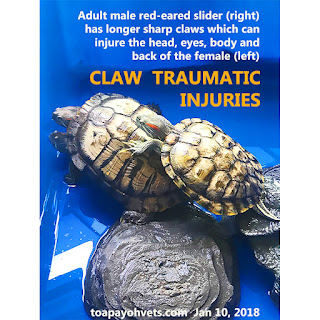How to trim the guinea pig's overgrown teeth using the Dremel 300 Cutting Wheel
SCRIPT FOR VIDEO PRODUCTION
HOOK
(Actual footage of the case during consultation)
Healthy
guinea pigs eat a lot. When they eat less, there is usually a medical
problem. Many times, the loss of appetite is caused by something
happening to their teeth. A person's adult teeth remain the same
size. But an adult guinea pig's tooth keeps growing longer daily. The
guinea pig chews hay and hard food to wear down the teeth. If he does
not eat, his teeth will not be properly worn out. The teeth overgrow
as in this 4-year-old, male guinea pig. The guinea pig will die
from malnutrition and weight loss over the next few weeks.
The
owner consulted Dr Sing Kong Yuen of Toa Payoh Vets on May 8, 2016.
This guinea pig has not been eating for the past 4 weeks. The
owner was worried. Video clip of a guinea pig with overgrown
front teeth during consultation). This condition can be serious as
the guinea pig will die from hunger if he cannot chew his food.
BKTP
(Image) SEE BELOW
TITLE (Image) SEE BELOW
INTRODUCTION
A
normal guinea pig has 4 front teeth. Two are upper and two are lower.
But this 4-year-old male guinea pig has 6 front teeth. Over the past
4 weeks, the owner has fed him less hay and carrots. The
teeth continued growing as they were not close to each other to
be worn out by the chewing the hay and carrots. They grow longer
and curved inwards towards the tongue.
(Video 1.
Consultation, history taking and examination)
BE KIND TO
PETS
VETERINARY EDUCATIONAL VIDEO
HOW TO TRIM THE OVERGROWN
TEETH USING THE DREMEL CUTTING WHEEL
TREATMENT
There
are two ways of trimming the teeth. A nail cutter or the cutting
wheel. The nail cutter may fracture the length of the tooth. The
cutting wheel trims the teeth evenly and smoothly without fracturing
the tooth. This video shows how Dr Sing uses the Dremel 300 cutting
wheel to trim the teeth.
(Videos 2,3,4,5)
VIDEOS
2.
Equipment used. (Include image and list them).
3. Anaesthetic gas is piped inside the container. The guinea pig is given the minimal dose of isoflurane gas anaesthesia to prevent stress and pain during tooth trimming. He is placed inside a gas container.
When he looks sedated, he is taken out for trimming. When he wakes up, he is placed inside the container again. This careful short anaesthesia ensures that he will not die from anaesthetic overdosage.
4. The Dremel 300 cutting wheel spins and cuts the teeth layer by layer
It is used with great care. It is important that the guinea pig's tongue and cheeks or the operator's fingers are not cut. Safety is most important for the pet and operator. A rodent's mouth gag may be used.
5.
It takes time and lots of patience to trim the 6 front teeth. A
rushed job means giving high anesthetic dose or longer duration and
this will kill the guinea pig. The teeth are trimmed. The owner is
very happy. Follow up 2 days later - the owner says the guinea pig
has eaten more food now.
CONCLUSION
The Dremel
300 cutting wheel works effectively to cut the teeth smoothly,
without fracturing the sides of the teeth. An ordinary nail cutter
may fracture the teeth. General anaesthesia calms the guinea
pig and prevents traumatic injury to the tongue and lips due to
struggling and movements.
ADVICES TO THE OWNER.
1.
Separate from the other guinea pig so that he will recover. Feed more
hay and carrots.
2. Early Treatment is best to prevent
overgrowth of the cheek teeth. In this case, the cheek teeth have not
overgrown and do not need trimming or cutting. Do not wait four
weeks to seek treatment.
3. A permanent solution is to
extract all the 4 front teeth of the guinea pig to prevent the need
for trimming of overgrown front teeth.
FINAL VIDEO
THIS BLOG:
https://2010vets.blogspot.com/2021/01/3954-use-of-dremel-300-cutting-wheel-to.html














































